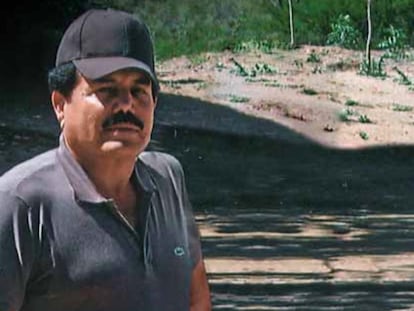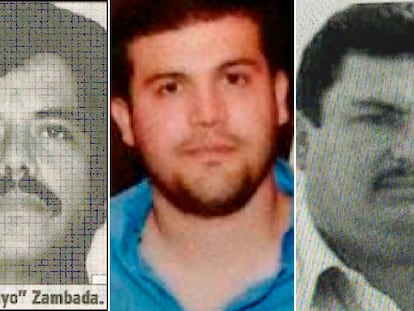El Mayo Zambada, the drug lord whose untouchable reputation is over
The veteran capo arrested in Texas spent more than 30 years in the upper echelons of the Sinaloa criminal empire without ever setting foot in jail thanks to a low, almost ghostly profile


‘El Mayo,’ the infamous leader of the notorious Mexican Sinaloa cartel, has always been an elusive figure. The 76-year-old veteran capo has moved around like a ghost, making it difficult to separate legend from reality.
He started in the drug trade at 16, at the end of the 1960s, when activities were limited to marijuana smuggling. A couple of decades later, he was one of the heads of a criminal empire. His associates have been picked off one by one, either imprisoned or dead. He himself seemed to be almost untouchable and cemented the myth in an unusual interview in 2010 with top Mexican journalist Julio Scherer. El Mayo invited him to a shack in the heart of the Sinaloa highlands. There, the journalist asked him how he had managed to escape jail and death for so long. He answered that he was a son of the mountains: “The mountains are my home, my family, my protection.”
Fourteen years have passed since that interview and the myth has continued to grow: El Mayo lives underground; El Mayo is a traitor; El Mayo is the real boss of Sinaloa. Until July 25, when El Mayo, or Ismael Mario Zambada García, was arrested at a private airport in the border city of El Paso, Texas, after being tricked into boarding the plane by a high-ranking member of the cartel.

The ephemeral profile of El Mayo has contrasted with the loud ostentatious behavior of other capos, who like to show off their mansions, luxurious lifestyles and women. El Mayo never betrayed himself with the lack of discretion that did for ‘El Chapo’ when he left a visible trail via cell phone messages of his flirtation with actress Kate del Castillo. It was this that facilitated El Chapo’s third and final capture in 2016. It has always been said that El Mayo was much more austere and disciplined, that he hid in the mountains and barely came down to the city.
As early as 1988, when federal police shot and killed Inés Calderón Quintero, another of Sinaloa’s pioneers, in Culiacán, El Mayo made himself scarce. Reports at the time say that the pair had been together days before, but that El Mayo decided to take a small plane and take refuge in his mountain hideout. Nearly 30 years later, during the operation that ended with El Chapo’s second arrest in 2014, newspapers were showing photos of soldiers lifting manhole covers under the headline “El Mayo is wanted.” Rumor had it that Zambada might be hiding in an underground tunnel.
Beyond the legend, the protection afforded El Mayo by the mountains has also been interpreted in Mexico as a metaphor that points to something less heroic. Journalism on the ground in Sinaloa has long pointed out that there existed a bridge between the government and the Sinaloa cartel, a shrewd strategy that would have allowed El Mayo to survive in the slippery ecosystem of the loyalties and betrayals of the underworld.
El Mayo was already in hiding in the late 1980s, when the first modern capo, Miguel Angel Félix Gallardo, nicknamed the ‘Boss of Bosses,’ sat the rest of the Sinaloa drug lords down together to divide up the pie in a more orderly and efficient way, making the cartel more like a company. Each of the seven capos was assigned a place in the country, a plaza in narco lingo. Zambada was assigned Sinaloa. El Chapo got Tecate, in Baja California. That was the embryo of the Sinaloa cartel, also known as The Federation.
Other versions of that meeting abound. For his book The Sinaloa Cartel. A story of the Narco’s Use of Politics, journalist Diego Enrique Osorno interviewed Gallardo in prison. Gallardo told him that the person who had called the meeting and assigned the work plazas would have been Guillermo González Calderoni, head of the anti-drug police squad at the start of President Carlos Salinas de Gortari’s administration.
The pact between the seven capos did not last long, and in the early 1990s war broke out. El Mayo and El Chapo joined forces against the Arellano Félix family, who controlled the prized Tijuana border. They won that war and, from the ashes, there emerged a new criminal architecture based on three main families: Guzmán’s, Zambada’s and that of Juan José Esparragoza Moreno aka ‘El Azul,’ an ex-cop who worked in the 1970s with another trafficker nicknamed ‘El Diablo’, married to El Mayo’s sister.

Over the following decades, the group grew into a multinational crime syndicate, with a presence in 17 states and 54 countries, according to DEA documents. All three founders made Forbes’ list of millionaires. Of the three, El Mayo was always the hardest to pin down. The underbelly of the Sinaloa Mafia was exposed in El Chapo’s New York trial which saw him sentenced to life in prison. During the trial, El Chapo – the man considered the most powerful capo in the world – insisted that El Mayo was the real boss of bosses in Sinaloa. At that trial, one of El Mayo’s sons, Vicente Zambada aka Vicentillo, testified against El Chapo, sparking the rumor that El Mayo had betrayed his compadre.
With El Chapo’s last arrest, the power structure fractured further within Sinaloa. And with the arrest of another of El Mayo’s longtime collaborators, Damaso López, the differences between the old guard, embodied by El Mayo, and El Chapo’s sons have become glaring in recent years. Known as the Chapitos, the new generation of young and ostentatious narcojuniors flaunt a life of outlandish excesses on social networks: leopards, guns and women. This behavior is somewhat alien to old hands like El Mayo, who is sometimes painted as a sort of Robin Hood figure that distributes money and builds roads and churches in the region’s poorer villages.
The latest DEA reports suggested that El Mayo was in poor health. At the same time, the U.S. authorities were closing in on him. Most of his associates, including his sons and his right-hand man, Aureliano Guzmán, alias El Guano, had already been arrested. The penultimate blow was the indictment by a New York court for trafficking fentanyl, the current number one enemy of the U.S.
A memo written in the first person on his behalf, reads: “Vanity is the worst enemy of this job. Step by step, I climbed the ladder. I’ve had power for many years and, from up here, I watch those who have wanted to knock me down fall.”
With El Mayo’s arrest, the myth is shattered of the man Scherer said was over 6 feet tall and had “a body like a fortress.” Zambada also said in that interview that he had a wife, five women, 15 grandchildren and a great-grandchild. “They, all six of them, are here, on the ranches, daughters of the countryside, like me.”
Sign up for our weekly newsletter to get more English-language news coverage from EL PAÍS USA Edition
Tu suscripción se está usando en otro dispositivo
¿Quieres añadir otro usuario a tu suscripción?
Si continúas leyendo en este dispositivo, no se podrá leer en el otro.
FlechaTu suscripción se está usando en otro dispositivo y solo puedes acceder a EL PAÍS desde un dispositivo a la vez.
Si quieres compartir tu cuenta, cambia tu suscripción a la modalidad Premium, así podrás añadir otro usuario. Cada uno accederá con su propia cuenta de email, lo que os permitirá personalizar vuestra experiencia en EL PAÍS.
¿Tienes una suscripción de empresa? Accede aquí para contratar más cuentas.
En el caso de no saber quién está usando tu cuenta, te recomendamos cambiar tu contraseña aquí.
Si decides continuar compartiendo tu cuenta, este mensaje se mostrará en tu dispositivo y en el de la otra persona que está usando tu cuenta de forma indefinida, afectando a tu experiencia de lectura. Puedes consultar aquí los términos y condiciones de la suscripción digital.
More information
Archived In
Últimas noticias
Raúl Rocha, from jet-setting with Miss Universe to arms trafficking and fuel theft
80,000 barrels of Mexican oil sent to Cuba: Havana drawn into the US–Mexico clash
Human rights activists, opposition members, and a minor: Maduro’s other political prisoners
Israel sparks a civil war within the MAGA movement
Most viewed
- Reinhard Genzel, Nobel laureate in physics: ‘One-minute videos will never give you the truth’
- Pablo Escobar’s hippos: A serious environmental problem, 40 years on
- Charles Dubouloz, mountaineering star, retires at 36 with a farewell tour inspired by Walter Bonatti
- Why we lost the habit of sleeping in two segments and how that changed our sense of time
- The Florida Keys tourist paradise is besieged by immigration agents: ‘We’ve never seen anything like this’










































